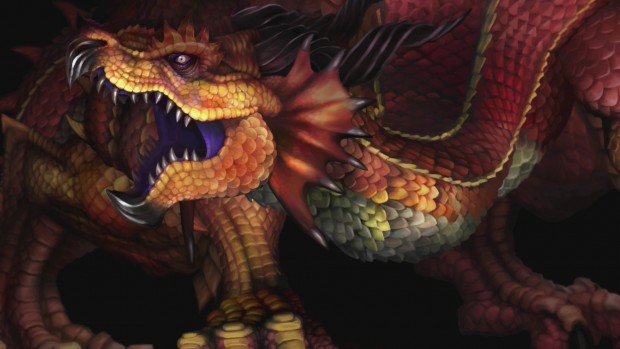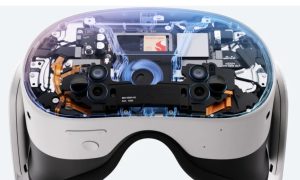
In the days that the arcades were popular, some of my favorite games were the side-scrolling beat-em-ups. The Final Fight machine ate up a fair share of my tokens, as well as X-Men and Teenage Mutant Ninja Turtles: Turtles in Time. Since then, the genre has been stagnant. Developers have been trying to translate the genre into 3D, but the transition has been rocky. When I saw that Dragon’s Crown was a side-scrolling action RPG, I thought about those old games and wondered if the RPG element would help create something fresh.
In Dragon’s Crown, you play as one of six different characters. They are the Fighter, Amazon, Elf, Sorceress, Wizard, and Dwarf. These are fairly standard in RPGs these days, so it shouldn’t surprise you that the Dwarf is strong and can yield a weapon in each hand. The Elf is quick and weak, so she attacks from a distance with her bow and arrow. The Fighter has a shield so he has the highest defense, quick attacks, and a short reach. Two-handed weapons are the forte of the Amazon. The Wizard and Sorceress are magic-users, with the Wizard having offensive spells and the Sorceress having a more supportive role and summoning skeletons to protect her. While you might think that some of the characters might play similarly, but each character has a distinctive feel. The advantages and disadvantages are balanced out among them, but some characters play a bit easier than others.
If anyone needs an argument for video games as art, they could pull out any Vanillaware title. Graphically their titles have always looked incredible with hand-drawn art. Dragon’s Crown is no exception, but their first offering in HD is spectacular. While the graphics aren’t as bright as previous games, the animations are crisp as ever. The black lines are more pronounced, highlighting the detail of the graphics. Some of the animations feel like a pop-up book with some layers in the foreground and others behind it. If the game was 3D compatible, it would be quite the sight to see.
[singlepic id=14973 w=320 h=240 float=left]The graphical effects in the game were not an afterthought. Dungeons are dark, but torches can light the way. The ambient light moves with the torch, and barrels are filled with flammable liquid. This means that you might go from a dark room to one that is burning up all around you.
While the fighting genre does get its fair share of sexism, the women in the game look like they were drawn in a 13-year-old boy’s mind. The intro with the Amazon was so unnatural that I couldn’t tell what the character was at first. The Sorceress is definitely magical, as her breasts grow bigger as she tries to straighten her back. It’s a miracle she can stand upright while handling her stave. The Amazon must believe that the best armor is no armor. Looking like a Cleopatra 2525 reject, most women’s swimsuits would offer more coverage. The woman who appraises your items has a perpetual bouncing chest. Even the women walking the street in the city hub have protruding mammaries that move up and down with each step. While the “breast physics” of the Dead or Alive series may be the butt of many jokes in the video game community, I would be more embarrassed playing Dragon’s Crown in front of my wife than Dead or Alive 5.
There isn’t any dialogue in the cutscenes. Instead a British actor narrates each scene deemed important enough to progress the story. He doesn’t sound too smug, but occasionally you can hear some smarminess come through. It’s surprising that none of the characters themselves actually have voices during the scenes you interact with them to help make the experience more immersive. The plot involves intrigue and politics, but in all honesty the story plays back seat to gaining quests, fighting, and acquiring loot.
The music in Dragon’s Crown is what you would expect for something of that setting. Trumpets blare to majestically pronounce the king and his royal family. Inside the dungeons, the tone is muted and somber, but it intensifies as the battle heats up and the bosses enter the picture.
The controls are fairly standard from what you would expect from a beat-em-up. You have your attack, action, and evade buttons. The inventory area to show what you currently have equipped to be used is located right above your head. It is hard to tell what is equipped, switch to what you want equipped, and get back into the battle. I had the most issues with the Square button, since it would both defend and attack. Sometimes it wouldn’t do the attack that I was expecting, making my character move quickly across the screen instead of stay in one spot doing quick attacks. It could be very disorienting to locate your character. However, there is more depth than the controls would indicate. You can mash the Square button for the entire game, but it will make the game a different experience if you evade, guard, and plan your attacks. This is especially true of the later levels.
[singlepic id=14967 w=320 h=240 float=right]Collecting money and finding items is an important part of the game. You can select items by moving the on-screen cursor with the right analog stick and selecting objects with the L1 button. This is fine while there aren’t any enemies on the screen, but it isn’t practical in the heat of battle. What is most disappointing is that you need to “touch” the name of your fallen comrade to resurrect them if they have lost all of their lives. This is difficult in the heat of battle when you need your party the most.
I admit I was a bit skeptical that an action RPG would work as a side-scroller. Most action RPG games have a top-down perspective. However, the change in perspective is a welcome change. Yfou can walk through the numerous areas and beat your way through them. They mostly come from the right side, which makes sense since you have cleared the areas behind you. The levels are relatively short as well, making it easy to finish a stage in a sitting without feeling like you are falling behind.
Plenty of opportunities to explore the levels do exist. Chests can be opened to gain treasure and items. Hidden items sparkle on the screen and come out when touched by the cursor. Doors can be opened that lead to more treasure, but also more monsters. Each of the dungeons has their own distinct feel due to the monsters they hold. You might be defeating bug-like creatures in one level, but ghosts and the supernatural the next.
If you are used to a slow pace with the brawlers in the game, don’t worry. All of the characters are relatively quick, making the fighting frantic. Having such an up tempo game gives you a sense of urgency to defeat the on-screen enemies. I never felt overwhelmed by the pace, though at times I felt like the bosses were moving faster than they should have.
[singlepic id=14948 w=320 h=240 float=left]That’s not to say that you won’t get your money’s worth. Each character has their own separate campaign that lasts 15-20 hours. You’ll have to work your way through each campaign, and once you get through the initial batch of stages, a new difficulty level opens up, giving levels alternate paths. You’ll have to defeat each boss within a specific time limit to acquire a talisman. Once all the talismans have been collected, another new difficulty level is unlocked and the level cap for the character goes up to 99.
You can upgrade your weapon using whatever spoils you have gained from each level. You can not only get equipment for your class but for other classes as well. You really can’t do much with whatever equipment you get for the other classes other than sell it. To equip anything, you need to have it appraised. You may just want to sell whatever you know isn’t for your class.
You can add members to your party by collecting up bones of already fallen warriors and taking them to the temple. There their bones can be resurrected and you can hire them at the bar. Trust me, while you can go alone, you will want to have other characters there to help you through your battles. Just be sure you can revive them. I wish you could have given your party members new equipment that you gained, but that’s not an option.
Another way to get others into your party is to have friends play online through the multiplayer. You can have three friends join you as you battle through the dungeons. You’ll just want to be sure that they are at a sufficient level to help you out through the dungeon or else you might be resurrecting their bone piles as well.
[singlepic id=14964 w=320 h=240 float=right]While the action is quick throughout the dungeon, things tend to slow down once you are in the main city hub. There you can go to the Adventurers Guild and get quests, go to the castle or wizards tower to get your next mission, and use the temple for getting blessings and reviving piles of bones. The tavern can be the place to tell of your tales of battle (saving your game), and gain allies for your party. The shop where you can get your equipment repaired and your loot appraised will constantly make you feel like you need to go there after every level to upgrade your equipment. This can slow the game down when all you really want to do is beat up some bad guys.
If you own Dragon’s Crown on the PS3 and the Vita, you can cross-save your game. That means that you can upload your save game from your PS3 and download it to your Vita, and vice versa. It is kind of surprising that there isn’t any cross-play or cross-buy option with this game, especially when the cross-save is an incredibly nice feature.
Vita Perspective:
When VanillaWare promised that both games would be identical, they really delivered. There differences between the PS3 and Vita versions are minor. The controls are nearly identical. The Vita version does implement the touch screen, so instead of using the right analog stick for opening chests or searching for treasure, all you do is touch the area of the screen you want to explore. When a member of your party needs to be revived, you just need to touch their banner at the top of the screen to bring them back into the action, provided you have enough coin.
The graphics and sound are identical, though I felt like the characters were smaller on the Vita screen. Some slowdown is evident when a large number of enemies are on the screen, but it really isn’t noticeable throughout most of the game. Also, since the Vita isn’t easily viewed by onlookers, you are less likely to get dirty looks while playing the game in public.
Dragon’s Crown is a fun game, and the charm evident in previous Vanillaware games translates well into HD. The action is fast and furious, and it’s a game that can be played in multiple sessions or short bursts. As long as you can handle the tedium in the city trying to find your best loot and the depictions of the characters throughout the game, then Dragon’s Crown is worth taking a look at, especially if you own both a PS3 and Vita.
While not working as a Database Administrator, Keith Schleicher has been associated with Gaming Trend since 2003. While his love of video games started with the Telestar Alpha (a pong console with four different games), he trule started playing video games when he received the ill-fated TI-99/4A. While the Speech Synthesizer seemed to be the height of gaming, eventually a 286 AT computer running at 8/12 Hz and a CGA monitor would be his outlet for a while. Eventually he’d graduate to 386, 486, Pentium, and Athlon systems, building some of those systems while doing some hardware reviews and attending Comdex. With the release of the Dreamcast that started his conversion to the console world. Since then he has acquired an NES, SNES, PS2, PS3, PSP, GBA-SP, DS, Xbox, Xbox 360, Xbox One S, Gamecube, Wii, Switch, and Oculus Quest 2. While not playing video games he enjoys bowling, reading, playing board games, listening to music, and watching movies and TV. He originally hails from Wisconsin but is now living in Michigan with his wife and sons.

See below for our list of partners and affiliates:

























